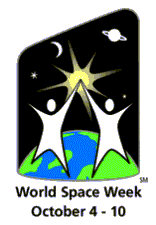
WHAT IS WORLD SPACE WEEK?

| The United Nations General Assembly has declared the time from October 4 to October 10 as World Space Week, "To celebrate each year at the international level the contributions of space science and technology to the betterment of the human condition." This was passed as a UN General Assembly resolution on 6 December 1999 WSW. |
World Space Week is an outreach program of the United Nations Office for Outer Space Affairs.
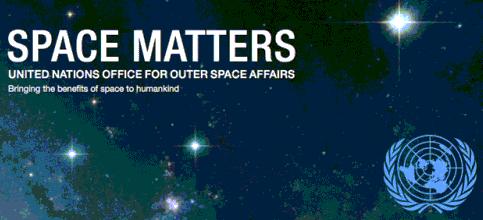
THEME FOR 2012 : SPACE FOR HUMAN SAFETY AND SECURITY
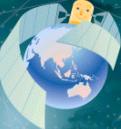 | The theme for World Space Week 2012 recognizes the important role of space in securing our world and protecting human safety. This is depicted in the World Space Week 2012 poster, sponsored by the Secure World Foundation. |
Many World Space Week events this year are also expected to recognize the late astronaut Neil Armstrong, the first human to set foot on the Moon.
PREVIOUS SPACE WEEK THEMES
IN MEMORIAM

Neil Armstrong (1930 - 2012) - First man to walk on the Moon.
SAFETY FROM SPACE
Many satellites in Earth orbit provide us information that is essential to protect lives and property on the Earth beneath. We examine here only two facets of these space assets that affect daily life on the planet.
METEOROLOGICAL SATELLITES
Meteorological satellites in low Earth orbit and in geosychronous orbit not only provide information to produce daily weather forecasts but also provide data to enabe the issuance of severe weather warnings that have saved countless lives.
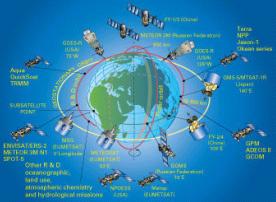
|
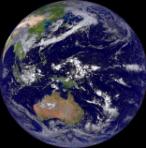 Left - meteorological satellites in various Earth orbits Above - an image from the Japanese GMS satellite |
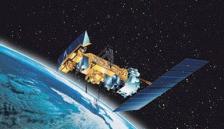 Above - NOAA meteorological satellite in low Earth orbit Right - a geosynchronous meteorological satellite |
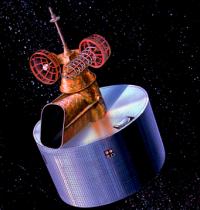
|
The diagram below shows the many facets of data collection and distribution that is the province of a Japanese meteorological satellite.
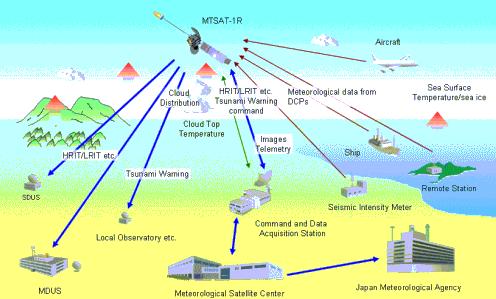
Severe weather warnings include warnings of cyclones (hurricanes, typhoons) to the general population and volcanic ash to the aviation community.

|

|
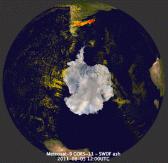
|
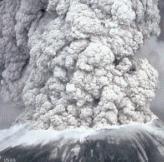
|
The diagram below shows the many space-based sources that feed into the Australian Bureau of Meteorology.
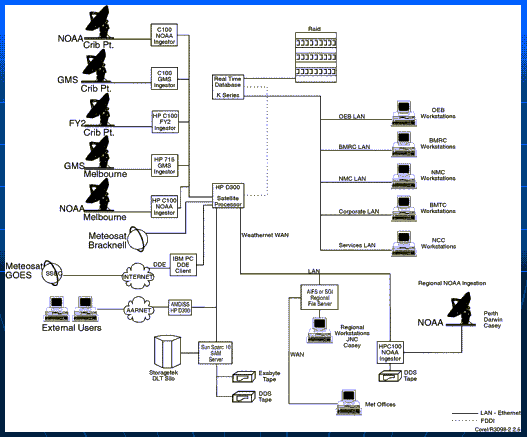
Here is a volcanic ash advisory issued by the Australian Bureau of Meteorology centre in Darwin.
Volcanic Ash SIGMETs received in the last 24 hours (global) IDD60102 VOLCANIC ASH WARNINGS [SIGMETs] DARWIN RSMC 22:46 UTC, 02/10/2012 -------------------------------------------------------------------- ***** Received at 23:15, 02/10/12 ***** LIRR SIGMET 05 VALID 022330/030530 LIMM- LIRR ROMA FIR VA CLD OBS AT 020440Z WI 15 NM E OF ETNA [N3745 E1500] FL070/110 MOV ESE 15 KT= ***** Received at 19:30, 02/10/12 ***** RJJJ SIGMET W02 VALID 021930/030130 RJTD- RJJJ FUKUOKA FIR VA ERUPTION MT SAKURAJIMA PSN N3135 E13040 VA CLD OBS AT 1908Z FL100 MOV S INTST UNKNOWN= --------------------------------------------------------------------
SARSAT/COSPAS
Several meteorological satellites carry an electronics package to aid in the rescue of people lost on land and sea, particularly those in survival situations, such as a sinking ship or a crashed aircraft.
The packages carried by US satellites and called SARSAT, and those carried by Russian satellites are called COSPAS. Canada and France are now also direct participants in the space segment of this system.
The ground based beacons that are detected and relayed by this system are variously referred to as ELT (Emergency Locator Transmitters), ELB (Emergency Locator Beacons) or EPIRB (Emergency Position Indicating and Reporting Beacons). These may be automatically (in the event of a crash) or manually activated. Their distress signals are received by the SARSAT/COSPAS satellites and relayed to ground stations. In Australasia ground stations are located in Alice Springs and in Wellington.
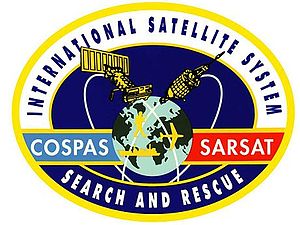 |
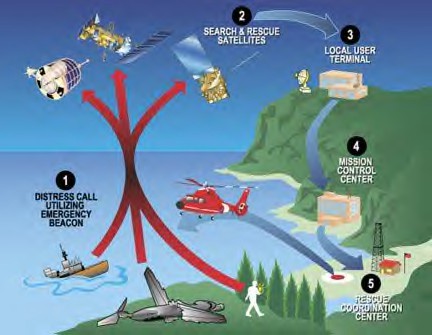
|
SPACE SECURITY
Security of space assets and space-based security of Earth include the facets of:
Space Sustainability
 | Ensuring that all humanity can continue to use outer space for peaceful purposes and socioeconomic benefit. This will require international cooperation, discussion, and agreements designed to ensure that outer space is safe, secure and peaceful. |
Space Situational Awareness
 | Space situational awareness is the characterization of the space environment and its effects on activities in space. This includes tracking of objects in orbit around the Earth using sensors located on the Earth and in space and space weather warning and prediction. |
Space Debris Mitigation
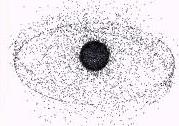 |
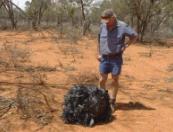
| Space debris is the collection of objects in Earth orbit which no longer serve a useful purpose and which were created as a result of human activity in space. |
Space Weather
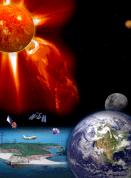 | Space weather is the state of the space environment and its effects on man-made systems. Most of our space weather originates with events on the Sun. Space-based and ground-based sensors continuosly monitor space weather, which has effects both on space-based and ground based systems. Space weather forecast centres around the world provide warnings and alerts of hazardous conditions. In Australia this is carried out by IPS Radio and Space Services |
Space Law
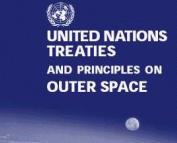 |
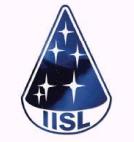 | Space Law is based upon treaties and resolutions of the United Nations. The International Institute for Space Law is actively involved in space law programs including education and outreach. Only through law can we fully reap the benefits of space in a peaceful and productive manner. |
Planetary Defence
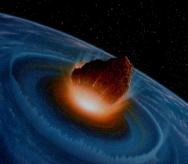 | Asteroids and Comets that come close to the Earth pose a possible collision hazard with global consequences. Several observatories around the world are devoted to monitoring the night sky in an attempt to catalog all potentially hazardous asteroids and comets. Various schemes for potentially mitigating this threat have been discussed. |
 Australian Space Academy
Australian Space Academy